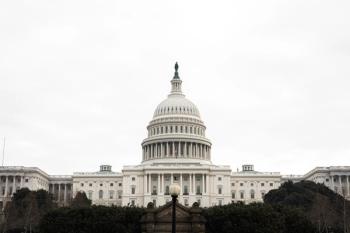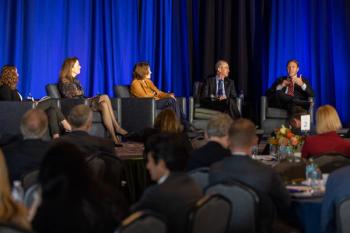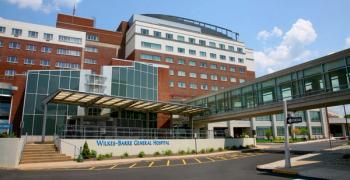
Craig Newman Highlights How Administrative Work Impacts Physicians' Ability to Provide Quality Healthcare
Craig Newman, the chief strategy officer at HealthChannels for ScribeAmerica, discusses the amount of time that physicians, nurses, and scribes spend on administrative work and how the pandemic has exacerbated the need for things to change.
Craig Newman, the chief strategy officer at HealthChannels for ScribeAmerica, discusses the amount of time that physicians, nurses, and scribes spend on administrative work and how the pandemic has exacerbated the need for things to change.
Transcript
How much of a physician’s day is spent doing administrative work and how does this time allocation impact the quality of care that patients receive?
Newman: As you know, there's about a million active physicians throughout the country working across the care continuum. And that may range depending on which care environment they're in—emergency medicine, the inpatient setting, urgent care, or the clinic-based environment. Or sometimes we think about home care. On average, most physicians are spending, just to give you a sense of the average clinic day—I'm just going to talk about the outpatient clinic—so if you're in clinical practice, you're spending between 9 minutes a clinic hour and 20 minutes of clinic hour, clicking, typing, or moving things around in the EMR [electronic medical records], navigating and working below license.
If you're in the inpatient setting, that may net out to about 3 hours of working below license. So, in a 12-hour shift, imagine 25% of the time we're paying our highest-cost FTEs (full time employees) to do remedial duties. And there's actually a study that came out in 2014, called time driven activity-based cost. And the idea behind this was how do we shift towards value and reduce costs models and think about, not just cost in terms of clinical cost, but also how we think about total costs from a labor spend perspective. And this gets to your point of how much time physicians spend below license.
Imagine they came up with an equation around capacity of a resource cost. And so, essentially, let's say if you make a quarter million dollars a year to $2 a minute. A nurse practitioner, if it's $100,000 a year, it's $1, a minute. A scribe or virtual scribe is the lowest cost, you'd see is like 35 cents a minute. So, on a minute-by-minute basis, you can begin to see and they've tested this up at Boston Children's Hospital, how much cost is going and time is being spent by a physician working below license, and how we can offset that information to a lower-cost resource, whether that's labor or technology, or a bit of both to drive value and improve care delivery models.
It was actually early on how we started thinking about the quadruple aim and really moving towards care-based models that drive high value, clinical care, reduce the cost of care and improve patient satisfaction all at the same time and getting doctors done by dinner. So, that was a long-winded way to say they are spending way too much time on clerical duties, and much less time than they should be on engaging with their patients, whether that's during the encounter or following up with them after the fact.
Again, I think they're it's a multiprong issue. There are challenges, obviously with flow, but physicians get behind because they have to spend so much time with clerical responsibilities that could be offset to a resource like a scribe or a virtual support model or digital assistant. That could be much more effective and if they were able to offload that work, they could actually not just run a much more efficient practice or have an efficient flow but, alternatively, they could potentially see more patients, which would improve the amount of time it would take a patient to get in the door. That's a huge problem we have in healthcare today is the wait times it takes for new patients to get in to see physicians, especially specific specialists where there may be shortages, and that problem is only getting worse for so many organizations across the country. So, those clerical components, we really need to take a hard and fast look at. That's why our company, we serve 3500 hospitals and health systems and over 2000 medical groups, this is exactly the focus. How do we reduce clerical burden from physicians and their care team to improve flow, reduce cost models, and drive value to patients?
How has the pandemic impacted administrative workload for physicians?
Newman: I'd say it's only increased. Again, this is a this is a big topic, right? So, hard to cover in a short interview today. But I'd tell you that, physicians, first of all, they're people just like everybody else. And you got to remember they've got family members, they've got other folks. So, they need to protect their time as well and have a work/life balance. The problem is, there's more work being put on them. When we moved forward in the pandemic, obviously, we had a hybrid delivery system. And what I mean by that is we moved from just having in person care to telehealth visits as well.
Well, that's not just a change for them. That's a change for their office staff, as well as for the patients, which means there's more steps that went into the process to make sure that we connected that provider with that patient. That's added burden right off the top. So, I'd say that's problem number one, because if a patient doesn't show up, or maybe a patient's 10 minutes late for that telehealth visit. Well, that backs up everything else throughout the course of the day and there's cascading problems.
But then there's another challenge that we have, which is labor shortages. I've worked with a number of health systems who ranged from having a 10% shortage of medical assistants, to a 30 to 40% shortage of medical assistants. Medical assistants, there weren't enough to go around pre-pandemic. Now, we're competing with, let's say even if we're paying a pretty good salary, they can go down the street to Dunkin Donuts, make $5 an hour more and get a signing bonus, it's a huge challenge. Or maybe they have they're providing home care or childcare for their kids. And so, we're seeing that shift. So, if there aren't medical assistants who can actually help support the provider with flow, or even do some of those additional ancillary duties, it's a huge challenge that backs up the clinician or adds to their day, which means they're spending more time at night on the weekends trying to play catch up with some of those remedial duties like documentation.
That's actually one of the reasons we have an arm of our company, ScribeAmerica, where we've actually leveraged the scribe as a care team assistant, whether in person or virtually, to actually help with some of those ancillary tests. So, it doesn't bog down the clinician, the care team. So, chart preps, documentation, pending orders, helping organize their time after the event like a personal assistant can really help drive and improve care delivery models and make life a little bit easier for the physician because at the end of the day, again, they're human. They're they're impacted by COVID-19 as well and so are their families and you want them done by dinner feeling refreshed because the last thing we need is to accelerate the burnout curve when we're already facing physician shortages.


















































